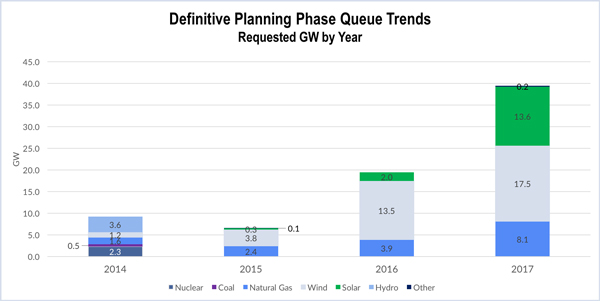By Amanda Durish Cook
MISO planners continue to sift through the largest batch of interconnection applications in a decade while still working out lingering details about the RTO’s new queue process.
In the last year the queue has grown to 355 projects totaling 58.8 GW.
“I don’t think we’ve ever had 191 projects enter the definitive planning phase at once,” said MISO planning manager Neil Shah, speaking about the August 2017 cycle of projects, representing 32 GW. The RTO accepts new projects into its queue twice per year, in August and February.
Stakeholders participating in a Sept. 26 Interconnection Process Task Force (IPTF) conference call asked if all the proposed projects will complete the queue’s studies.
“From MISO’s perspective, they’ve submitted everything they’ve needed under the Tariff,” Shah said.
“There’s a lot of capacity in the queue, and a lot of it won’t come online, but a lot of it will,” CEO John Bear said during a Sept. 21 board meeting, adding that solar and renewables represent a large share of prospective projects. At the same meeting, Executive Vice President of Operations Clair Moeller noted that the queue hasn’t been so packed since 2007.
Amid the heavy queue workload, stakeholders must also decide whether to continue the IPTF under its current structure, or convert it into a working group to finish implementation of the new queue design, which is intended to streamline a process beset by restudies and backlogs. However, MISO staff have already warned stakeholders to prepare for delays as the approximately 100-employee queue team examines the copious amount of projects.
Rhonda Peters, a Wind on the Wires consultant, urged IPTF leadership to consider the switch to a working group.
“We have a lot of needs with this interconnection queue, and they’re not going away. They’re urgent needs. … We need to not waste time discussing a sunset date every six months,” Peters said.
Wisconsin Public Service’s Chris Plante said he was also in favor of moving to a more permanent working group organization, noting that he’s saved documents from 2008 IPTF meetings.
“We’re pushing 10 years here, and from a Stakeholder Governance Guide standpoint, that’s not temporary,” Plante said.
Vikram Godbole, MISO director of resource utilization, said the larger goal was that stakeholders continue working out a new queue process, whatever the venue. IPTF Chair Randy Oye asked for stakeholder comments on whether they support discussing interconnection issues under a working group or task force structure.
MISO attorney Jacob Krause also said the RTO is seeking written stakeholder feedback on the number of days that should be allowed for negotiating and executing generator interconnection agreements.
In early September, FERC ruled that MISO did not provide “sufficient support” for Tariff revisions that would have required that generator interconnection agreements be negotiated and executed within 90 days, down from the current 150 days. (See FERC Blocks MISO Plan to Shorten Queue Negotiations.)
Oye said he didn’t see why the RTO couldn’t shorten the agreement timeline by having interconnection customers and transmission owners simultaneously sign off on agreements. Currently, agreements are negotiated for 60 days, with customers given additional 60 days to execute the agreement. TOs then have another 30 days to sign off.
MISO staff asked for written comments so the issue could be taken up again in October.






